Mitla, Markets, Mezcal & the Mammoth Tule Tree
This is post number eleven from my recent tour of Central Mexico led by Adventures Abroad’s veteran guide Victor Romagnoli. Today we are going to visit Mitla, the ancient capital of the Zapotec culture that existed in central Oaxaca state for over a thousand years before being completely destroyed by the Spanish in the early 1500’s. Before reaching Mitla we’ll stop at the Tule Tree which is as old as the Zapotec civilization and still growing. We’ll also visit the Sunday market in Tlacolula and drop into the ornate church there. After lunch I’ll be challenging my fellow tour members to drink true Mexican Mezcal the way the Mexicans do – with a worm as a chaser. No, cancel that, it’s actually the tourists who get sucked into doing that. But hey I’m a tourist right, so let’s give a try.
The Mammoth Tree of Santa Maria del Tule
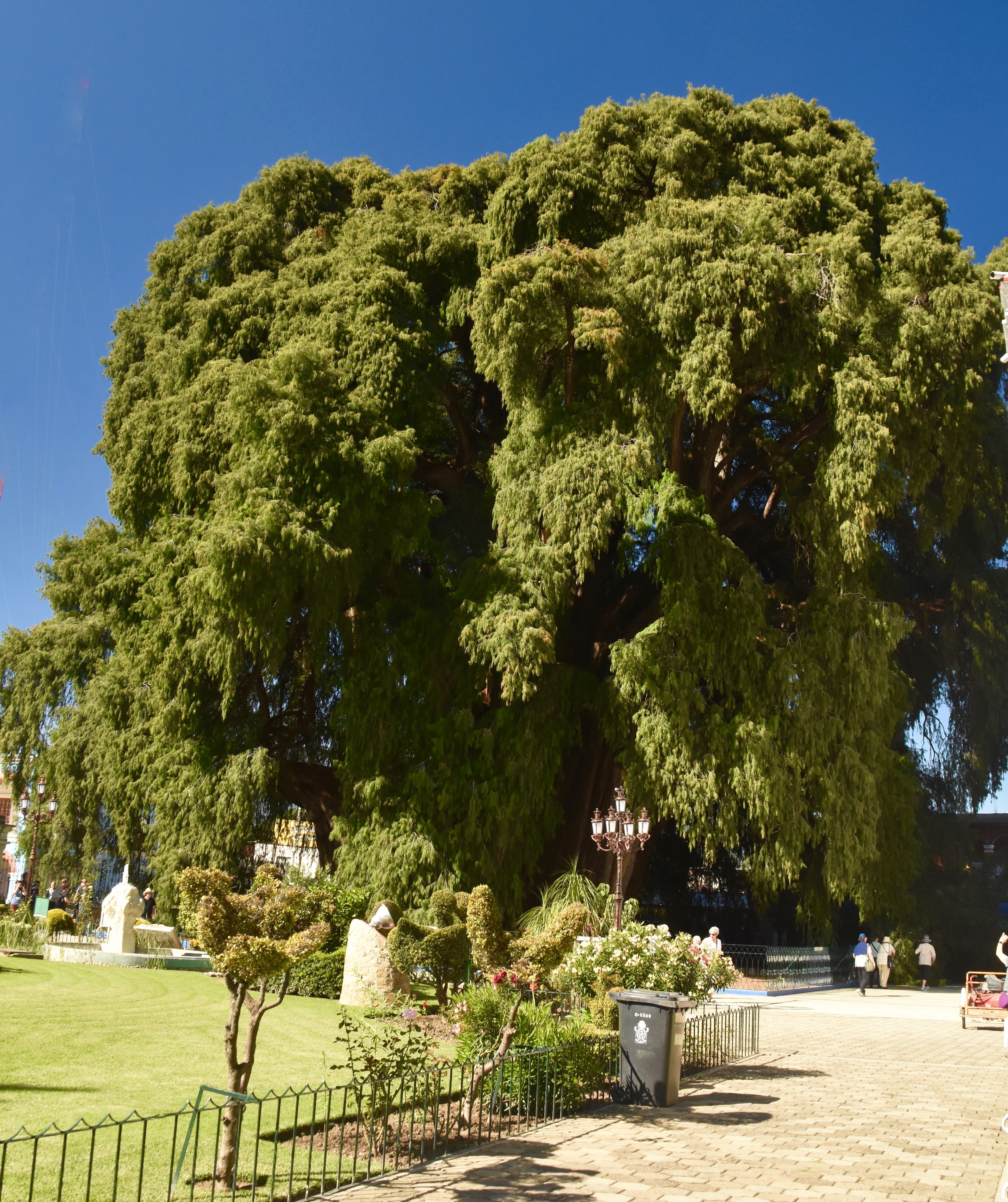
Our first stop after leaving the city of Oaxaca and heading southeast on Highway 190 is at the small town of Santa Maria del Tule where you’ll find this absolutely massive Montezuma cypress known as the simply the Tule Tree. A closer look at the trunk reveals that it is the widest tree in the world, almost 12 metres (40 feet) across. It also happens to be as old as the ruins we are headed to see in Mitla, over 1,500 years and still growing. One thing I can honestly say about Mexico is that I never expected to see world record trees, but it’s just another sign of actually how diverse central Mexico really is.
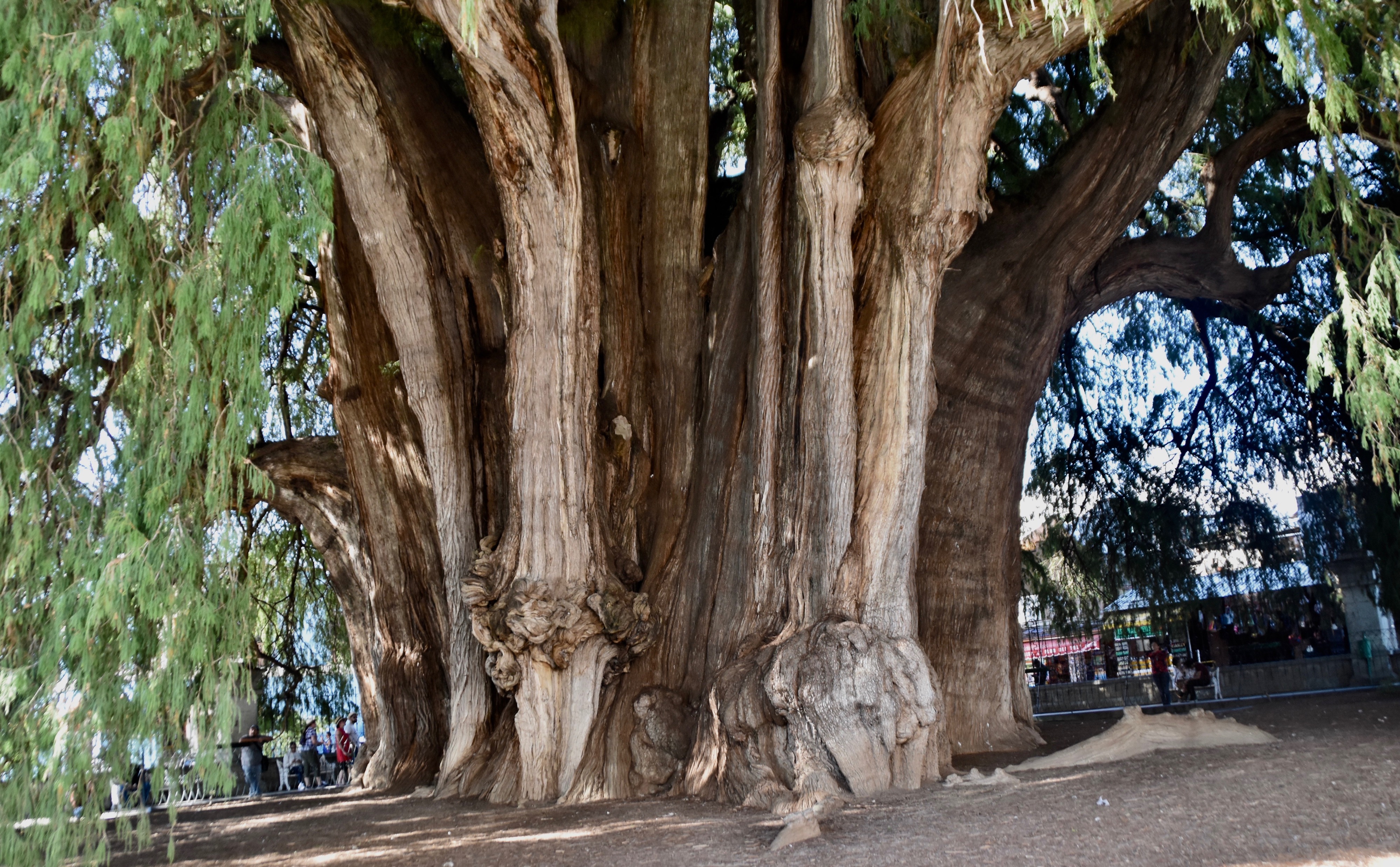
Tlacolula
Our next stop is the fairly small city of Tlacolula which Victor advises has one of the best and most authentic Sunday markets in all of Mexico and we just happen to be here on a Sunday. The bus stops just where the streets are blocked off for the market and we get out and follow Victor into an almost impenetrable maze of humanity. What is immediately apparent is that many of the women of the city, including even the younger ones, dress in traditional floral embroidery that is a feature of the Zapotec culture. In Tlacolula the term ‘local colour’ has an actual meaning.
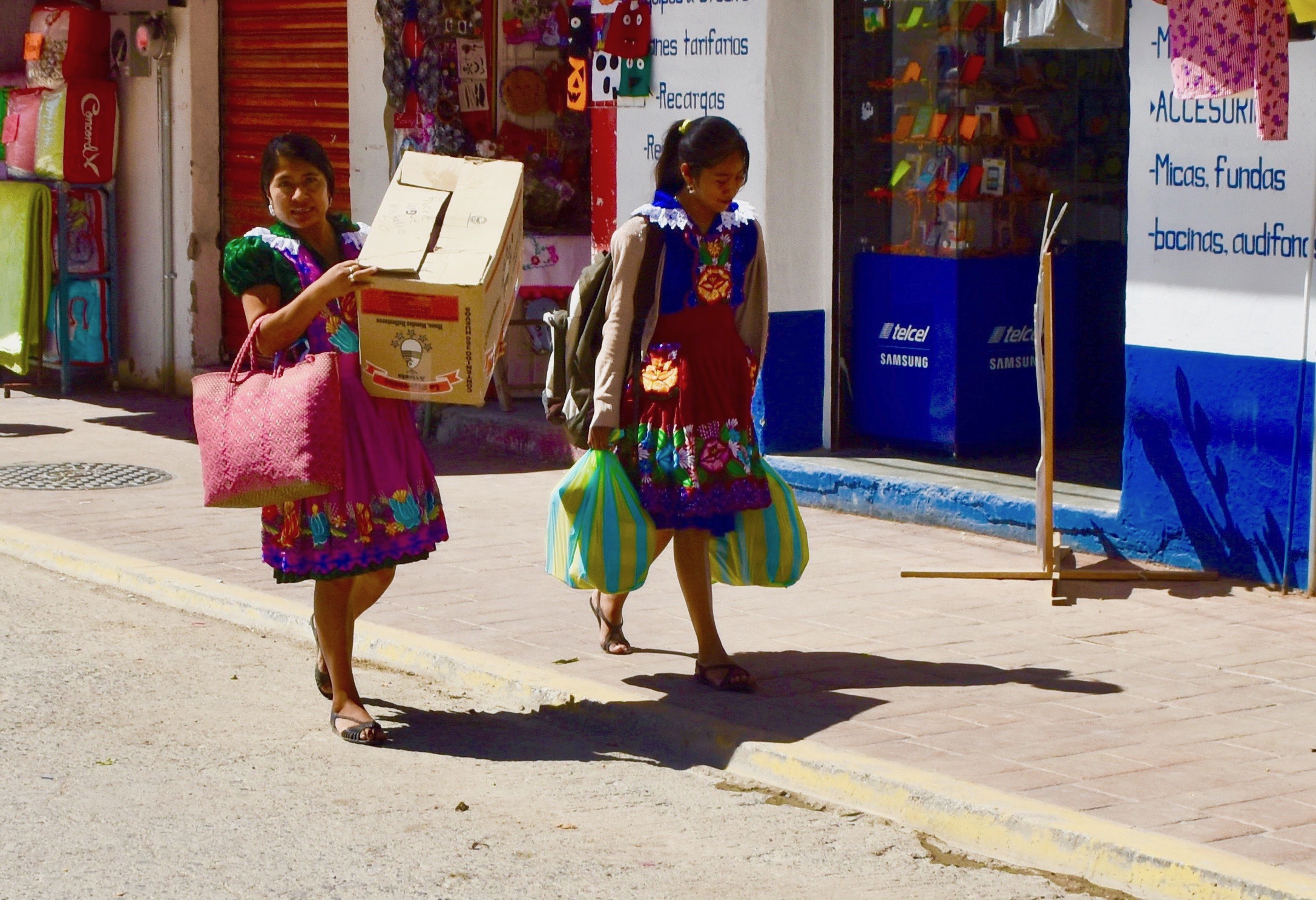
As noted in my last post from Mexico, one of the main reasons for being in Mexico at this time of year was to partake in the Day of the Dead celebrations that are a very important part of the lives of most of the people who live in the Oaxaca area. That is quite apparent from many of the items for sale in the market including this offering of skull candles which people will use to adorn the altars they build either at home or in the local cemetery.
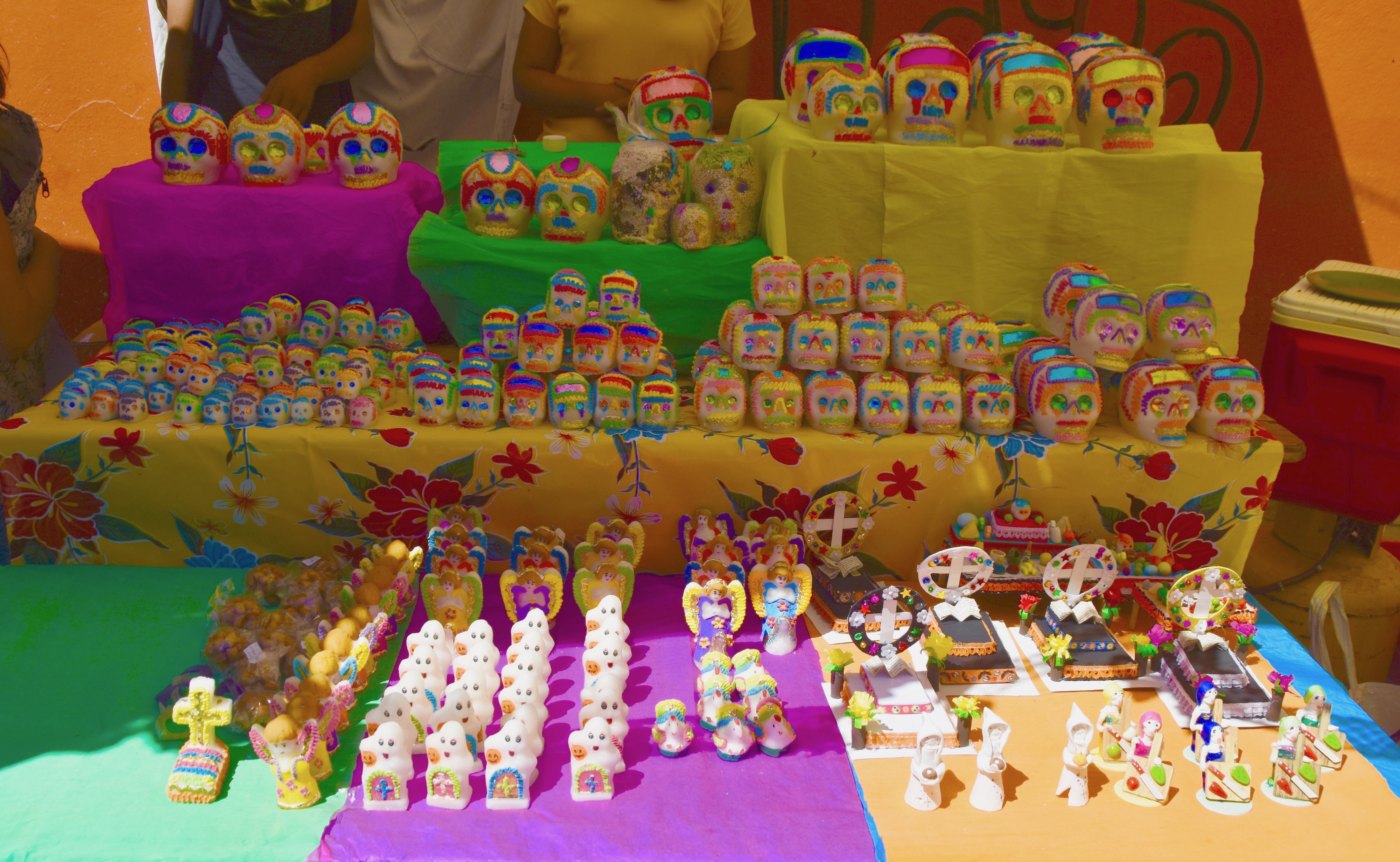
Also for sale by the thousands are the two flowers that are essential for Day of the Dead ceremonies – huge orange marigolds improbably referred to as Inca varieties and the pink to purple variety of celosia that we call cockscomb.
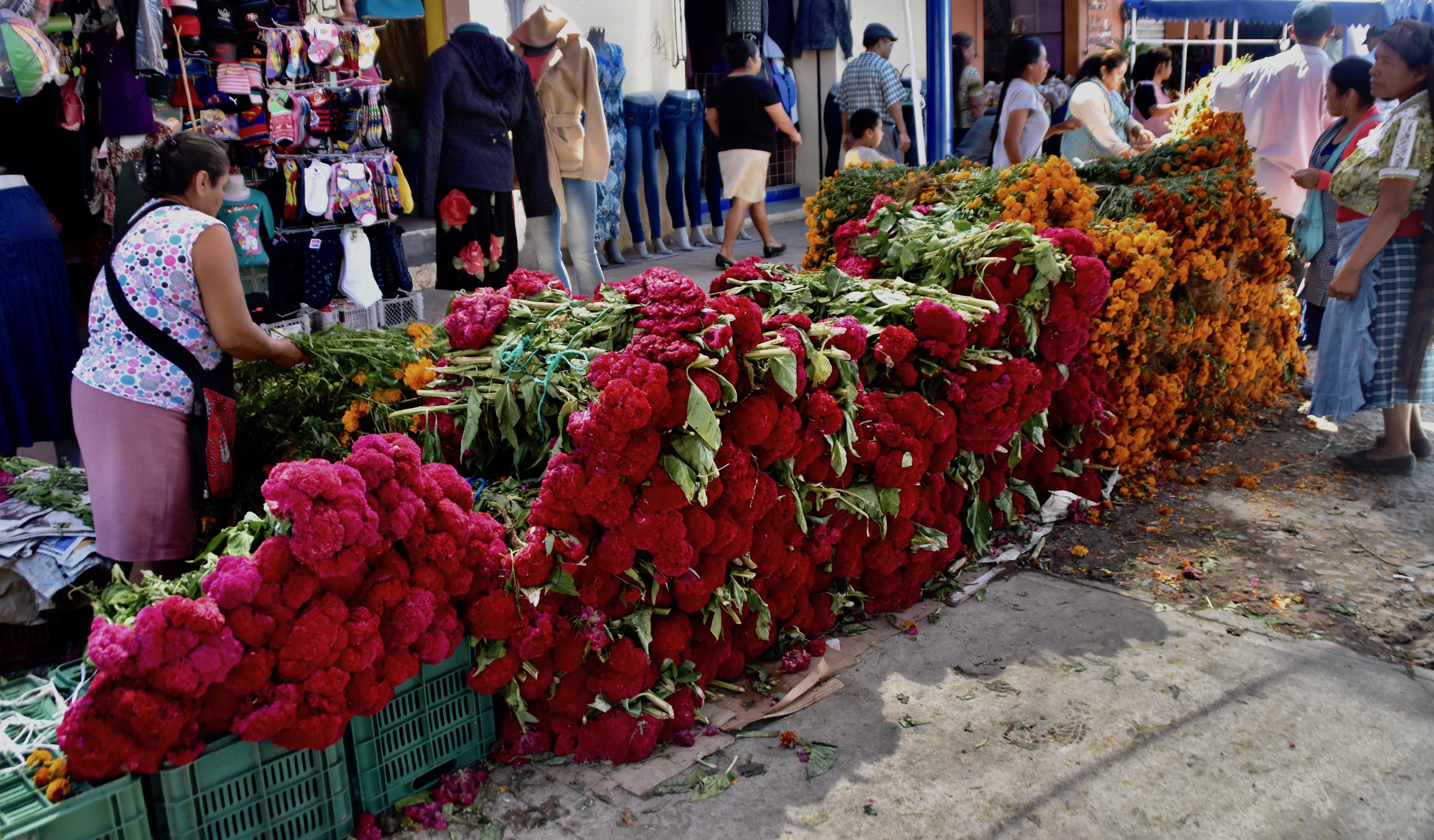
Also very popular are stands selling homemade Pan de Muerto (Day of the Dead bread) for which Tlacolula is justly famous. In fact, Oaxacans often eschew what is for sale in their city markets to drive the 30 kms. (18.5 miles) to Tlacolula just to buy its festive bread.
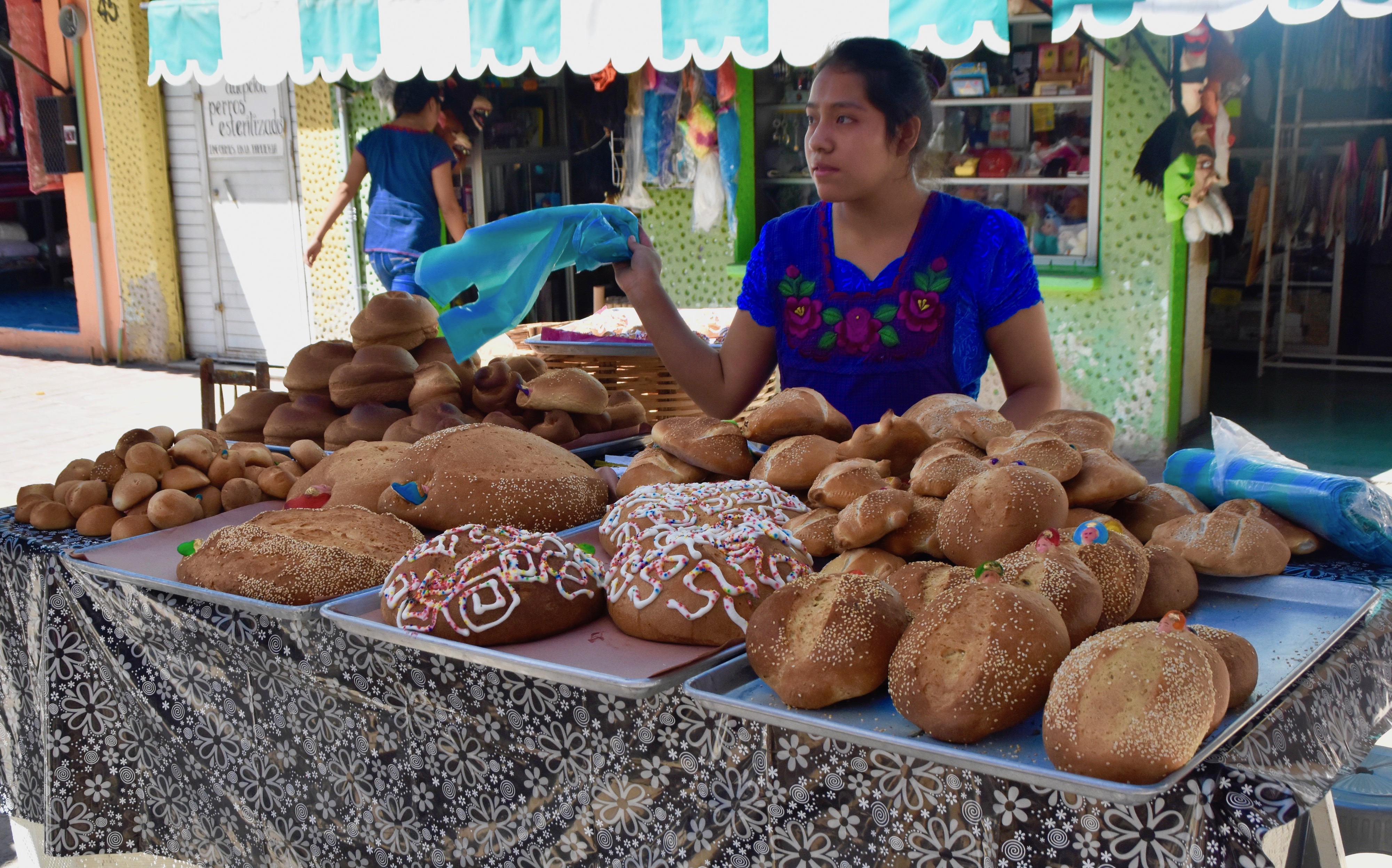
If you look closer you can see that one version of Pan de Muerto features little faces that represent various religious and other figures.
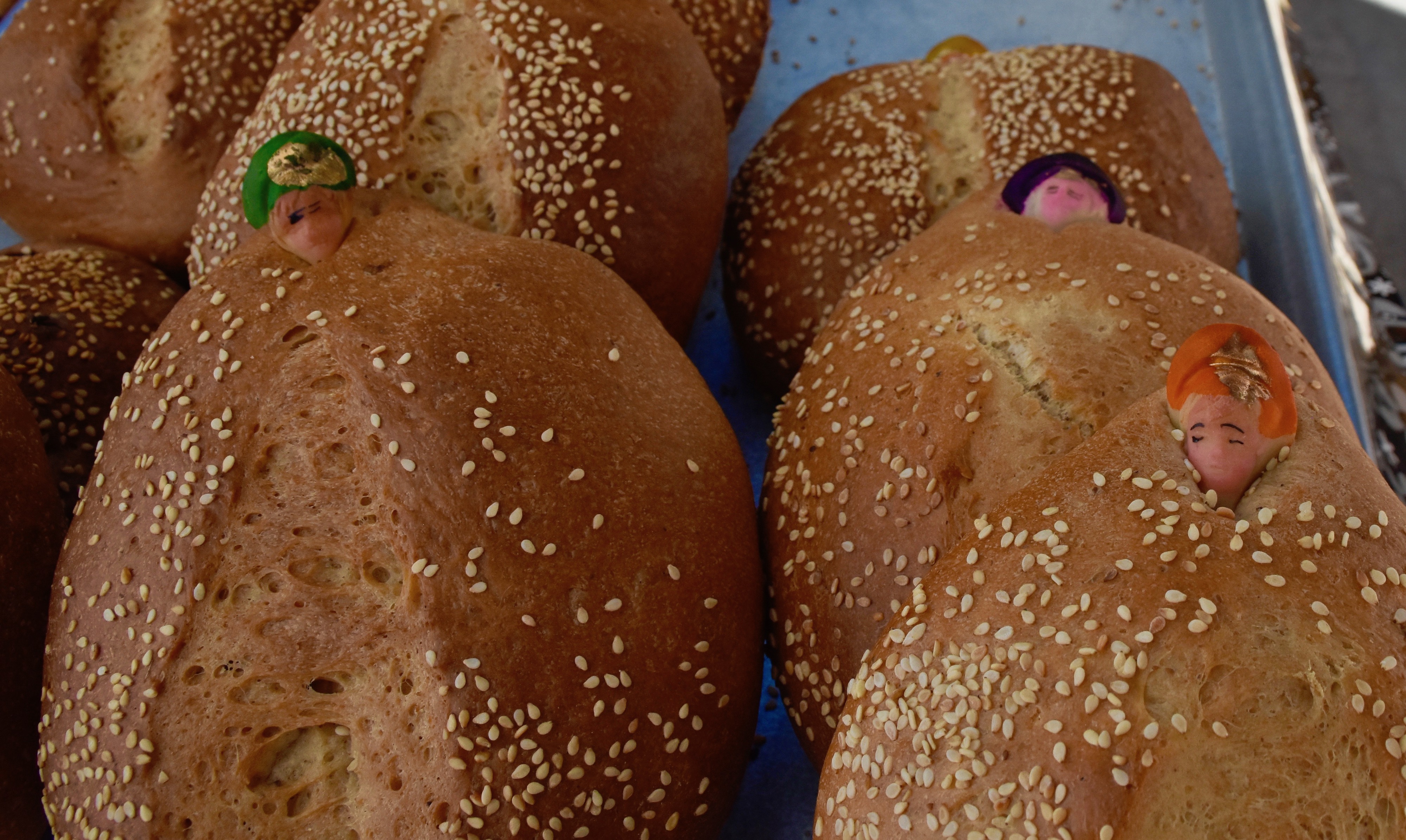
Of course no self-respecting Mexican market would be without a large selection of chilis for sale.
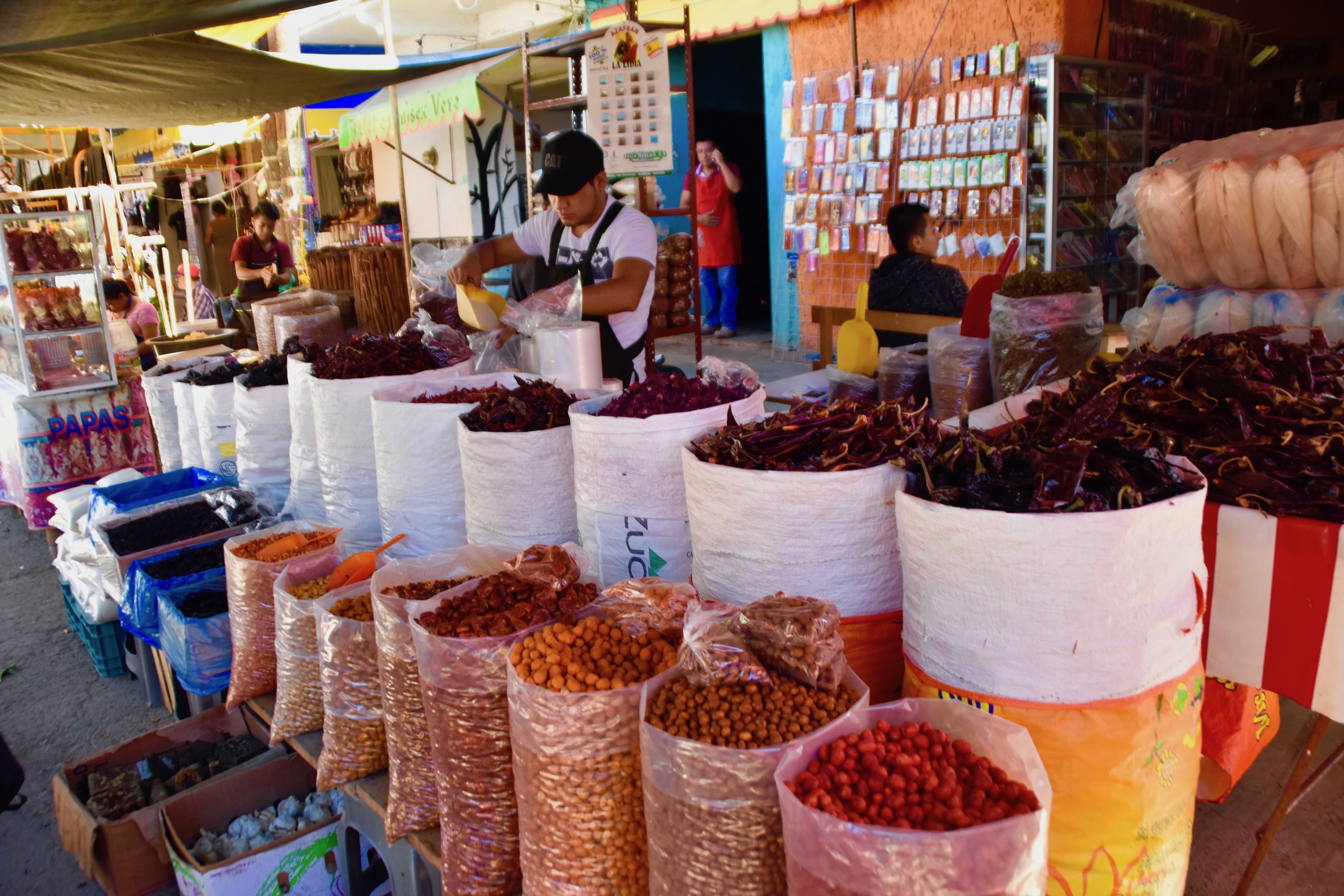
As well as something you will usually only find in Mexican markets – chapulines or dried salted grasshoppers as we would call them. During my time in Mexico I came to be very fond of these as a condiment in tacos, burritos and any Mexican egg dish like huevos rancheros. Trust me, they are actually very good.
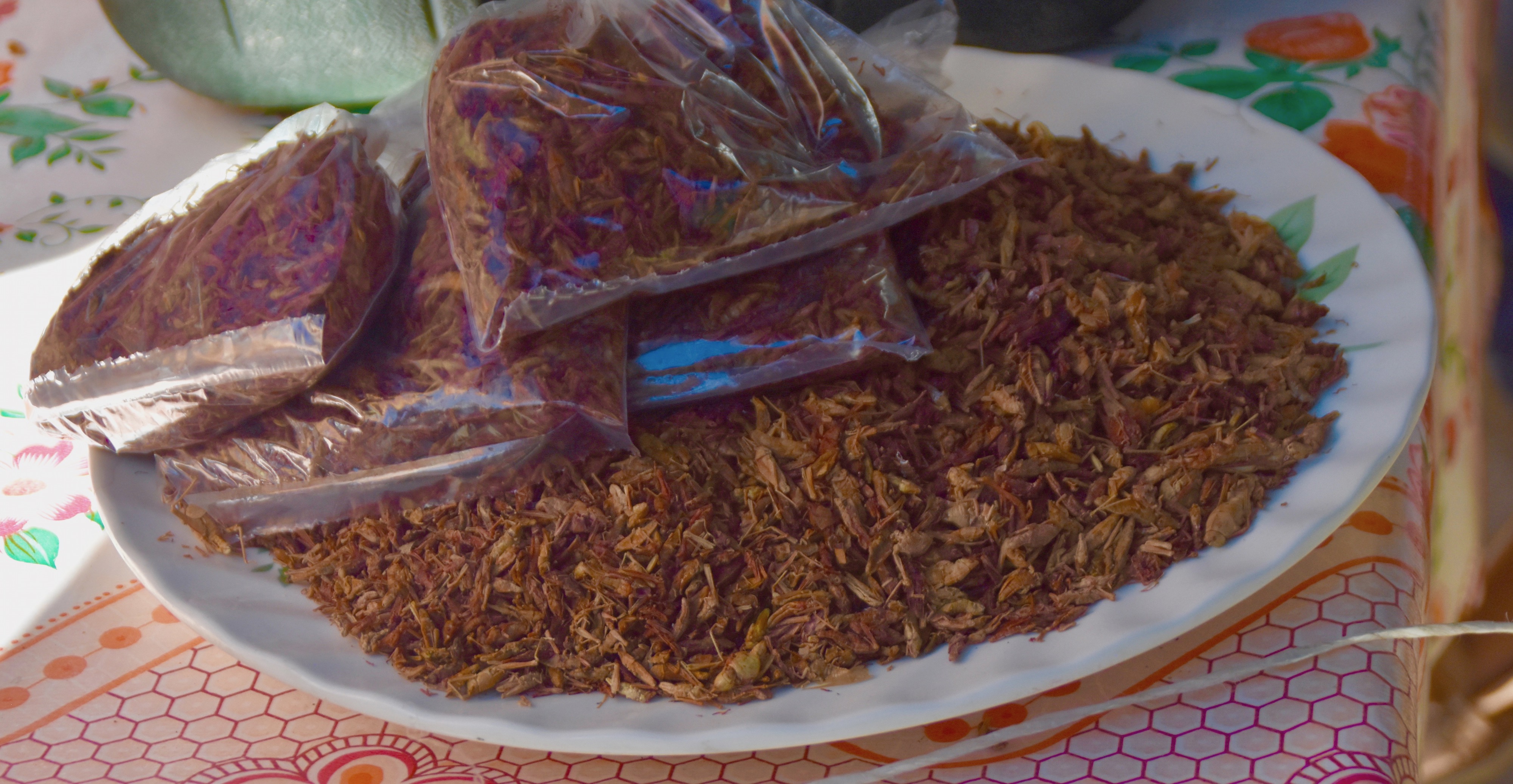
Exiting the street market into the main city plaza we stood in front of La Ascunción de Nustra Señora, the principle church of the area which dates back to the 1500’s.
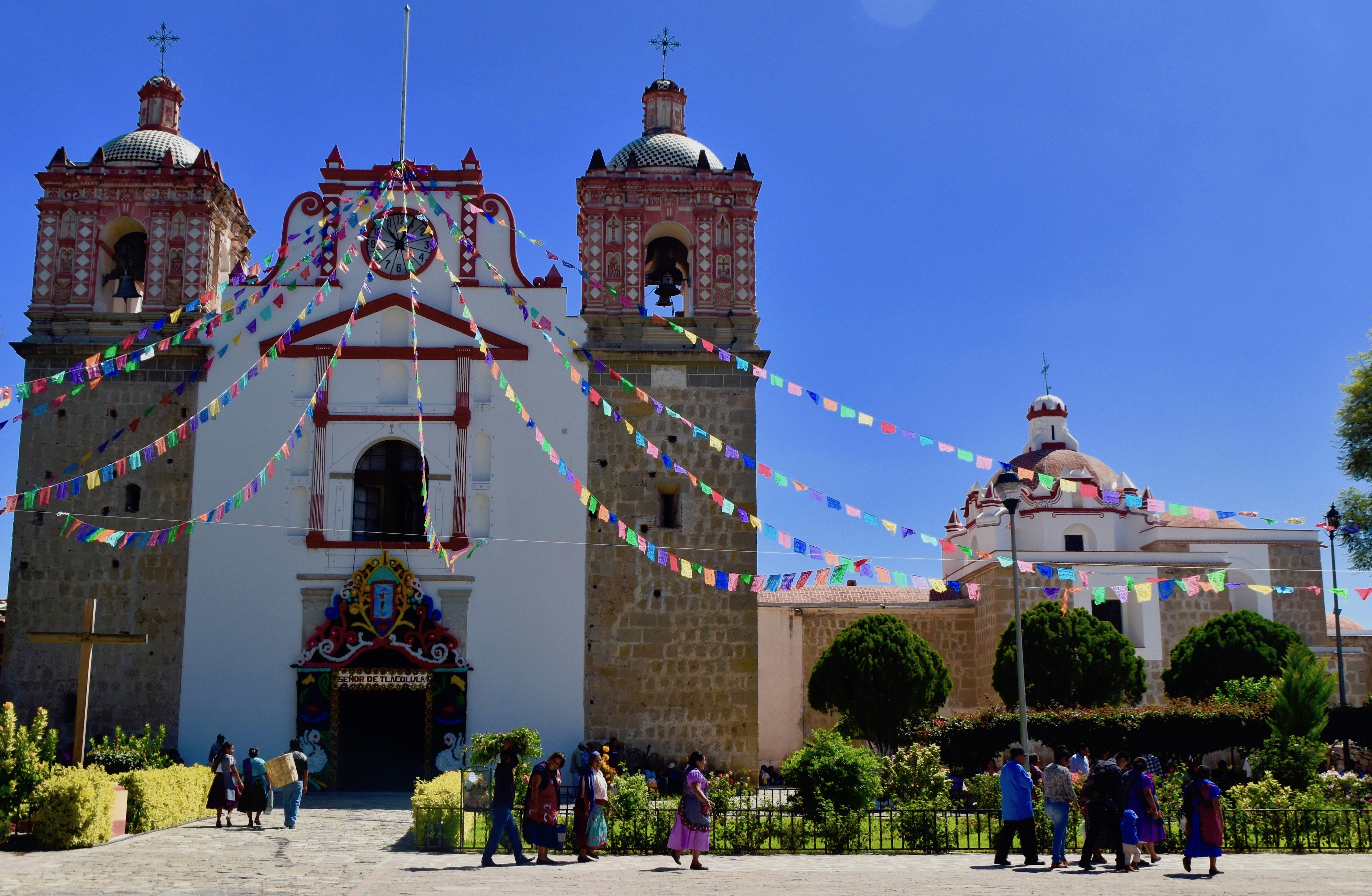
It was gayly decorated with streamers made from papel picados, the Day of the Dead paper cutouts that are ubiquitous in Oaxaca at this time of year, along with the customary altar around the entrance.
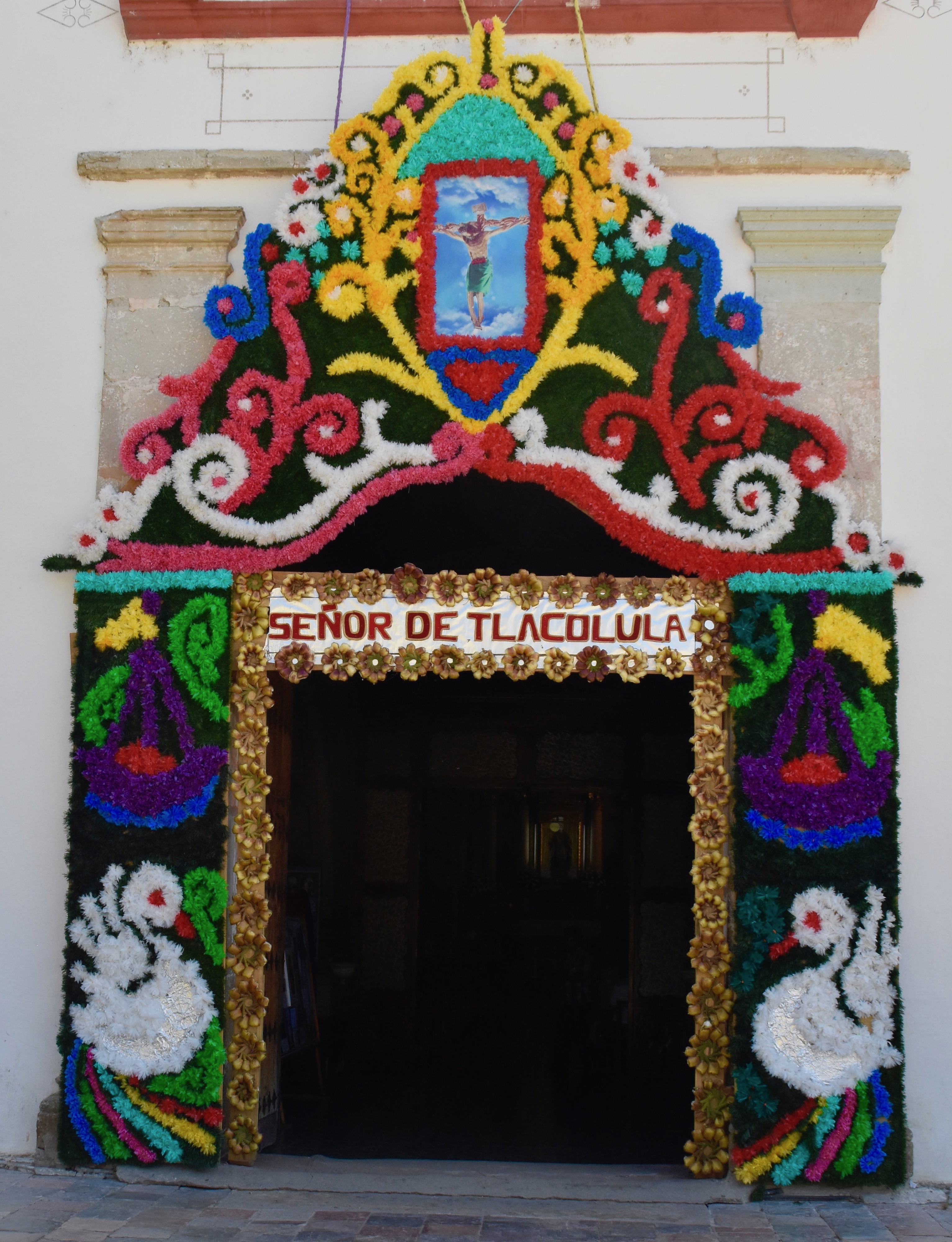
Inside is the Catholic church’s attempt at creating an empyrean setting by covering every possible square inch in gold and silver gilt. These over the top interiors in small places like Tlacolula remind one of just how much wealth there was in pre-Columbian Mexico and how much of it was misappropriated by the church in the name of God. If there is a God and I severely doubt it, I cannot think that he/she/it would approve of this type of adoration at the expense of keeping the average Mexican in a state of poverty and powerlessness for centuries.
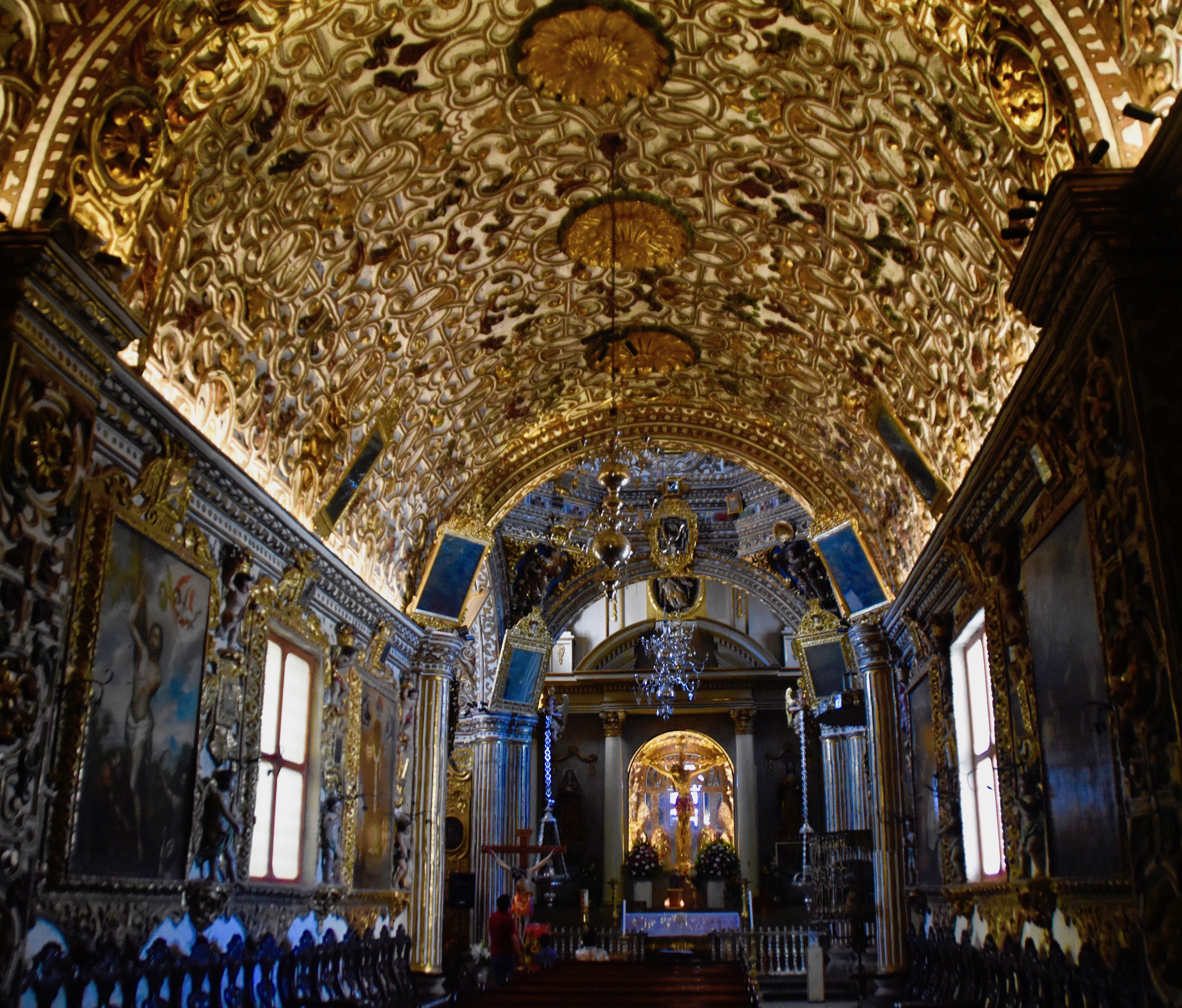
However, I can appreciate the artwork in these churches, particularly the usually wood carved statues of saints, martyrs and the Holy Family. This is St. Peter of Verona who was an opponent of the Cathar heretics that were prevalent in southern France and northern Italy from the 12th to the 14th century before almost all were killed by Inquisitors, of whom good old St. Pete was one. In return for just doing his duty as a good Catholic the Cathars had him assassinated by way of hatchet to the head and dagger to the heart. This may be where the idea for that gruesome Halloween gag that features an axe to the head originated. You learn the strangest things in the strangest places.
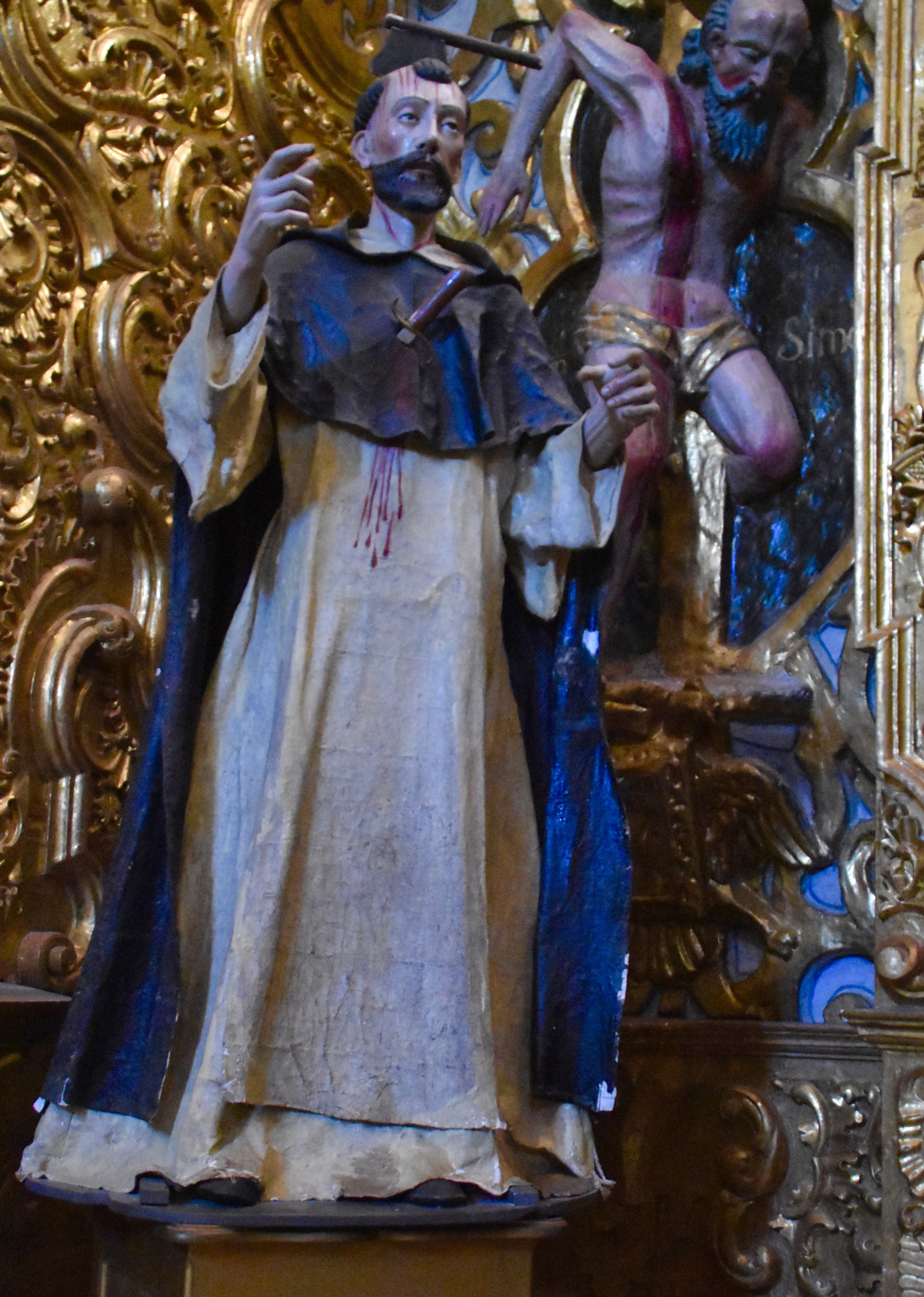
Why a gentlemen from Verona would be venerated in a church in Tlacolula, Mexico is beyond me. I’m sure there is another story lurking behind the scenes.
OK, that’s our daily dose of religion, time to move on to Mitla.
Mitla
Two days earlier we visited the amazing Zapotec city of Monte Alban which may have the most beautiful setting of any archaeological site in Mexico. It was the fortress city from where the Zapotecs and later the Mixtecs were able to exert control over the central Oaxacan valleys, among the most productive in pre-Columbian Mexico. Mitla rose to prominence from around 700 – 900 after Monte Alban began to decline, for reasons no one can say with any certainty. Mitla is located in the valley of Oaxaca state and not atop a mountain like Monte Alban. It was still occupied by the Zapotecs when the Spanish arrived in the early 1500’s. Between the church and the conquistadors it is hard to say who did more damage. The bottom line is that the Spanish pretty well destroyed Mitla which they apparently viewed as a centre of paganism and barbarity.
Today very little remains of Mitla and frankly I was quite disappointed at how little there was to see considering the relative importance that is attached to it as a Zapotec city. This is the entry point not far from the small parking lot. There were very few other tourists around, not even as many as the few we ran into at Monte Alban.
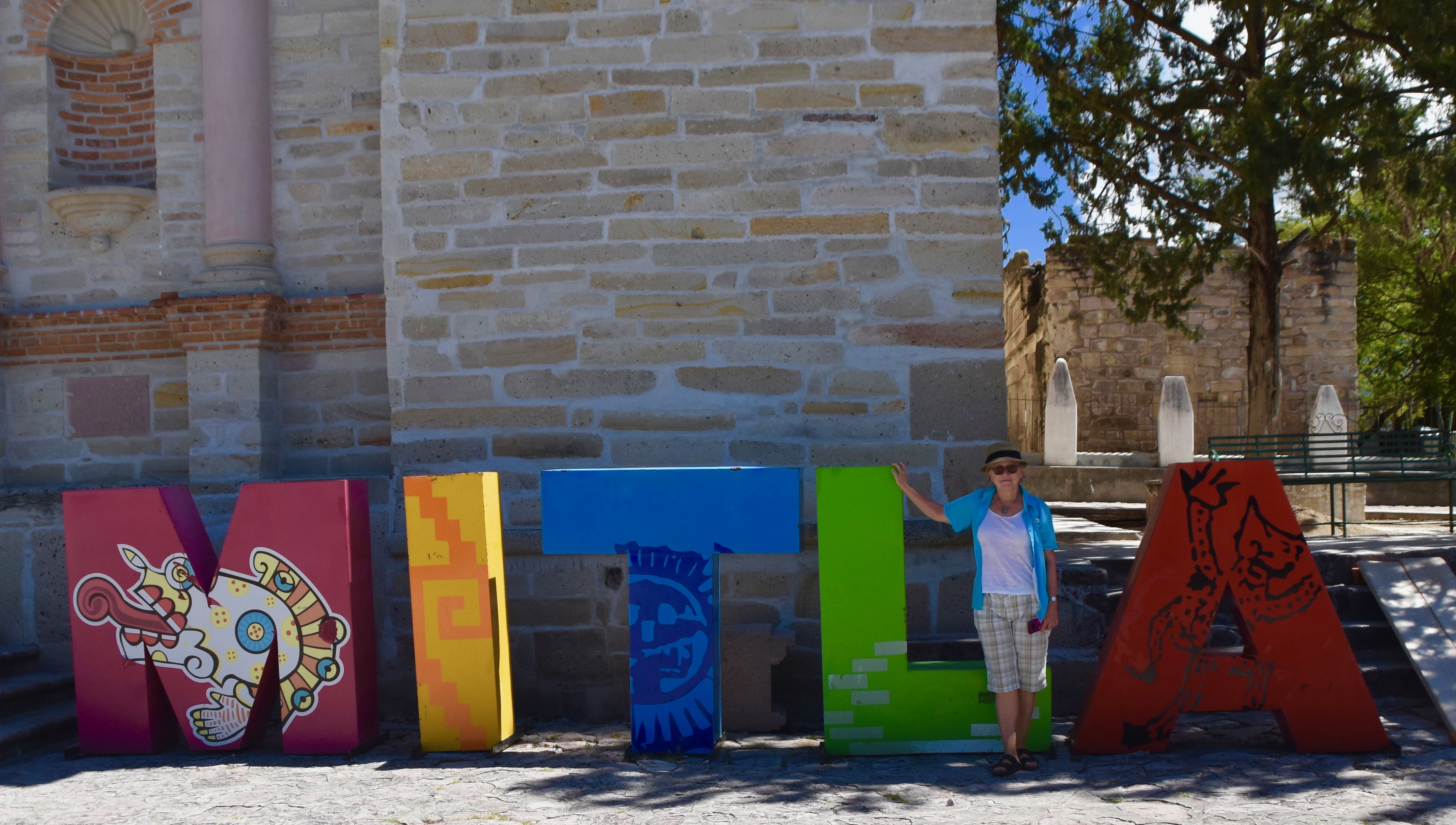
The first thing you see is this and its symbolic implications are glaringly obvious. To stamp out an old religion you literally build a church on top of the temple you have just destroyed.
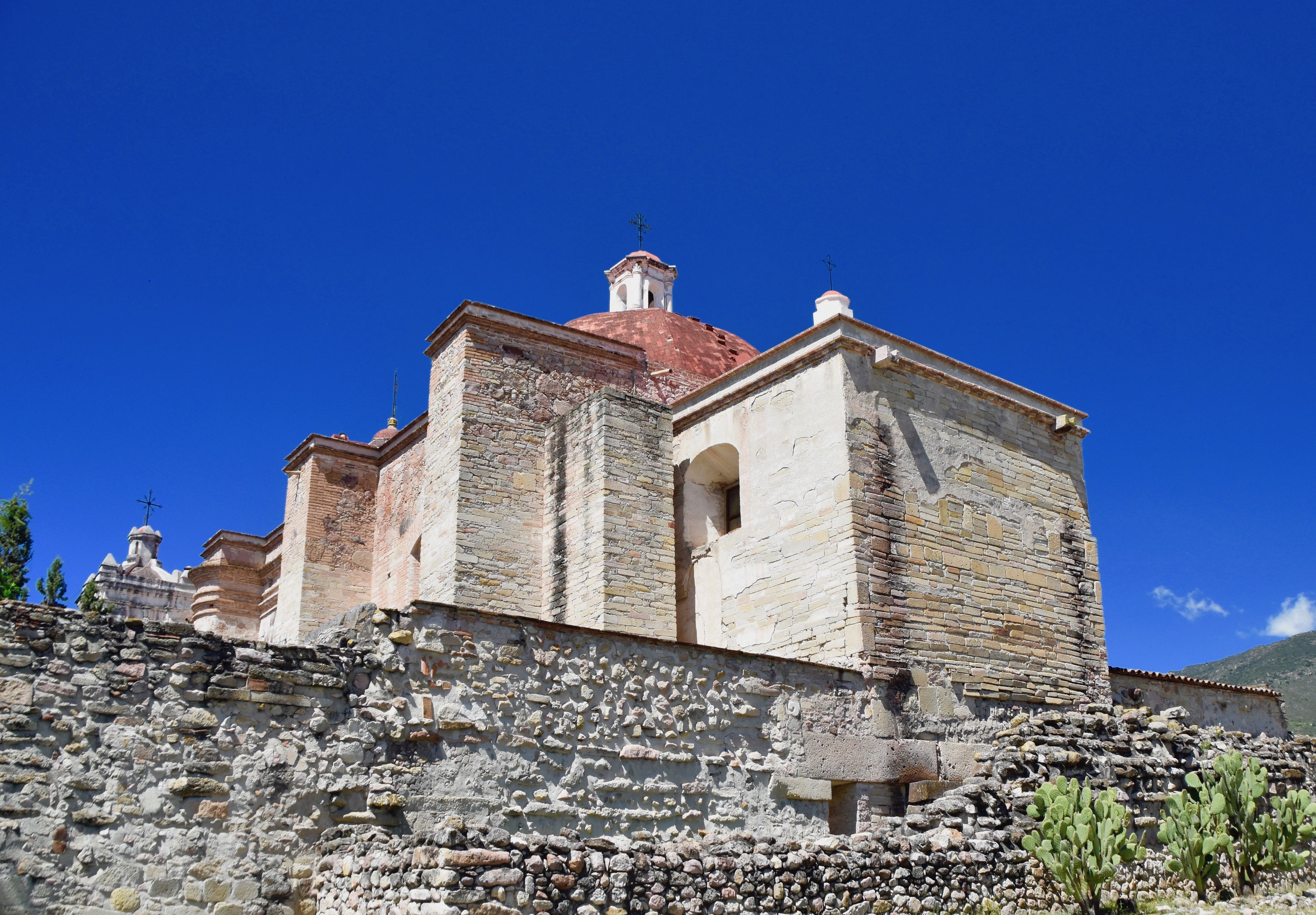
The one thing Mitla is renowned for are the various stone friezes that line the interior walls of a number of the surviving buildings.
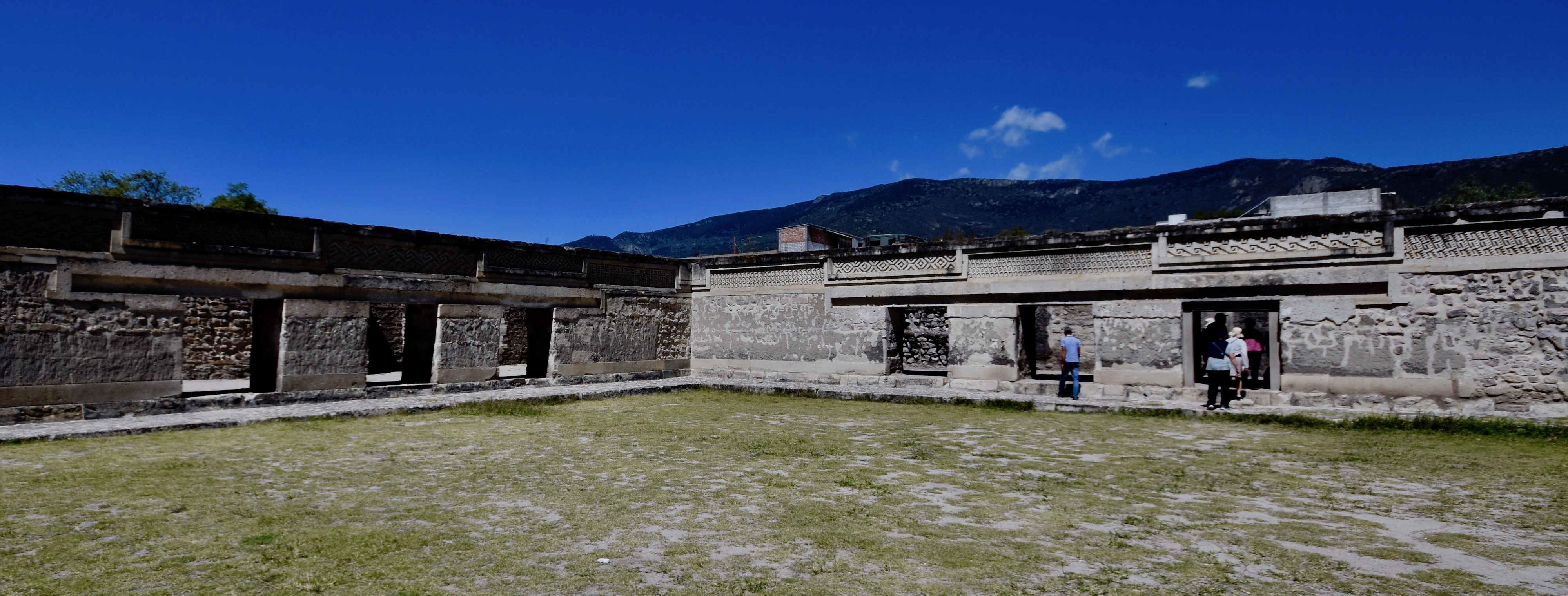
The friezes are made of individual small stones set in geometric patterns and held together without benefit of mortar. Let’s have a closer look at a few of them.
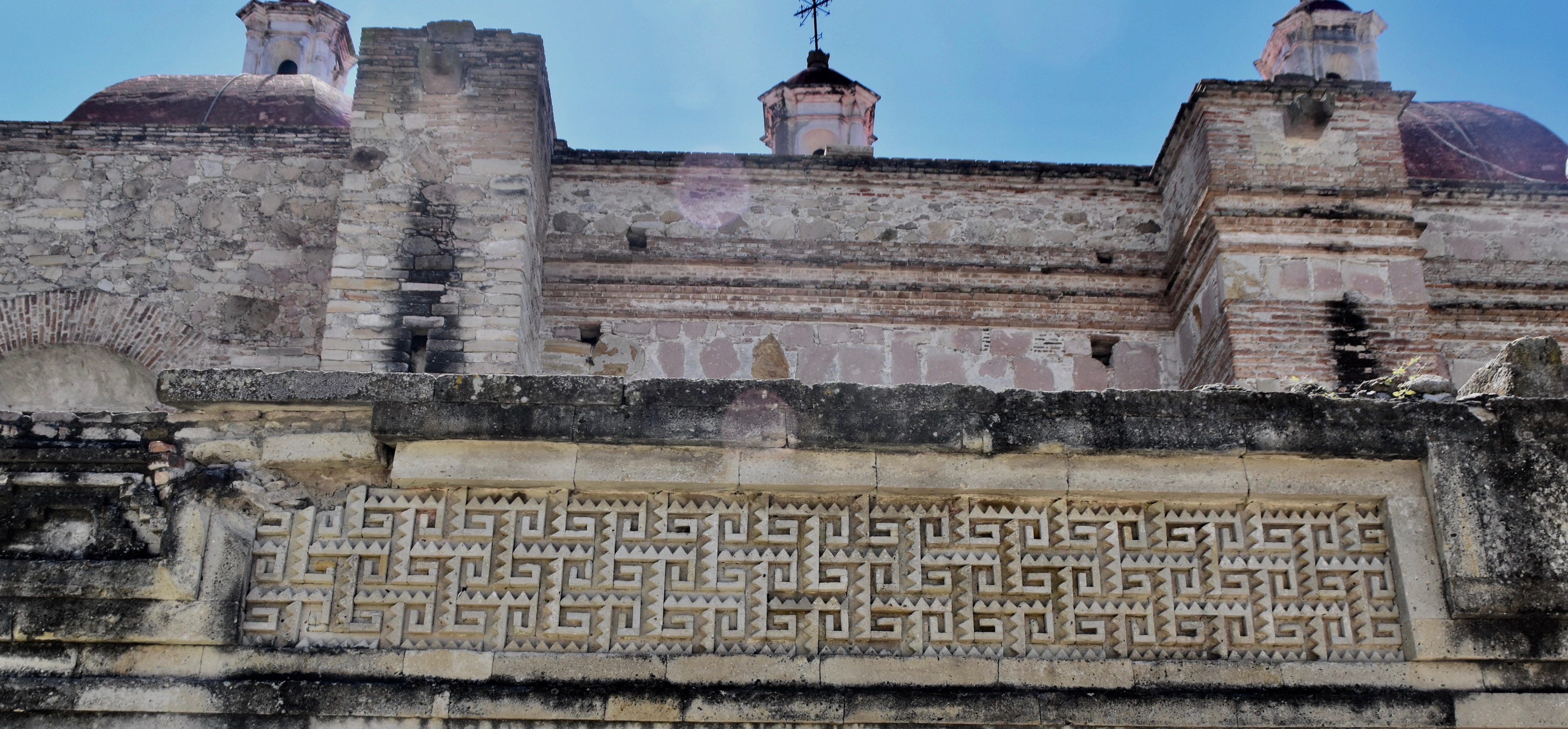
I couldn’t help but notice how similar this pattern is the Greek key or meandros that you find throughout the ancient Greek world.

This one reminded me of a much more modern style you see in Soviet era portrayals of marching soldiers.

I wonder what the Spanish made of the crosses in the centre of this frieze? The cross was a common motif in many cultures and had nothing to do with Christianity.

Are these stairways or just an eye-pleasing pattern?

More marching men or just a bit of trompe l’oeil?

Every frieze is different and they found nowhere else in Mexico. Why they developed as a decorative art form in Mitla and only Mitla, is unknown and probably always will be. I’m just glad I was able to see and appreciate them. At least the Spanish didn’t destroy everything.
By now we’d already had a pretty busy day and I think most were glad for a stop at a large roadside Mexican buffet which featured a great variety of Oaxacan specialties including a number of varieties of moles. The guisados you see advertised in this photo are braised meats that you put on tortillas and then add either mole or salsa (or both) to enhance the flavour. Washed down with one of the craft beers that Oaxaca is rapidly becoming known for, you have a tasty, authentic and inexpensive lunch in a typically Mexican setting.
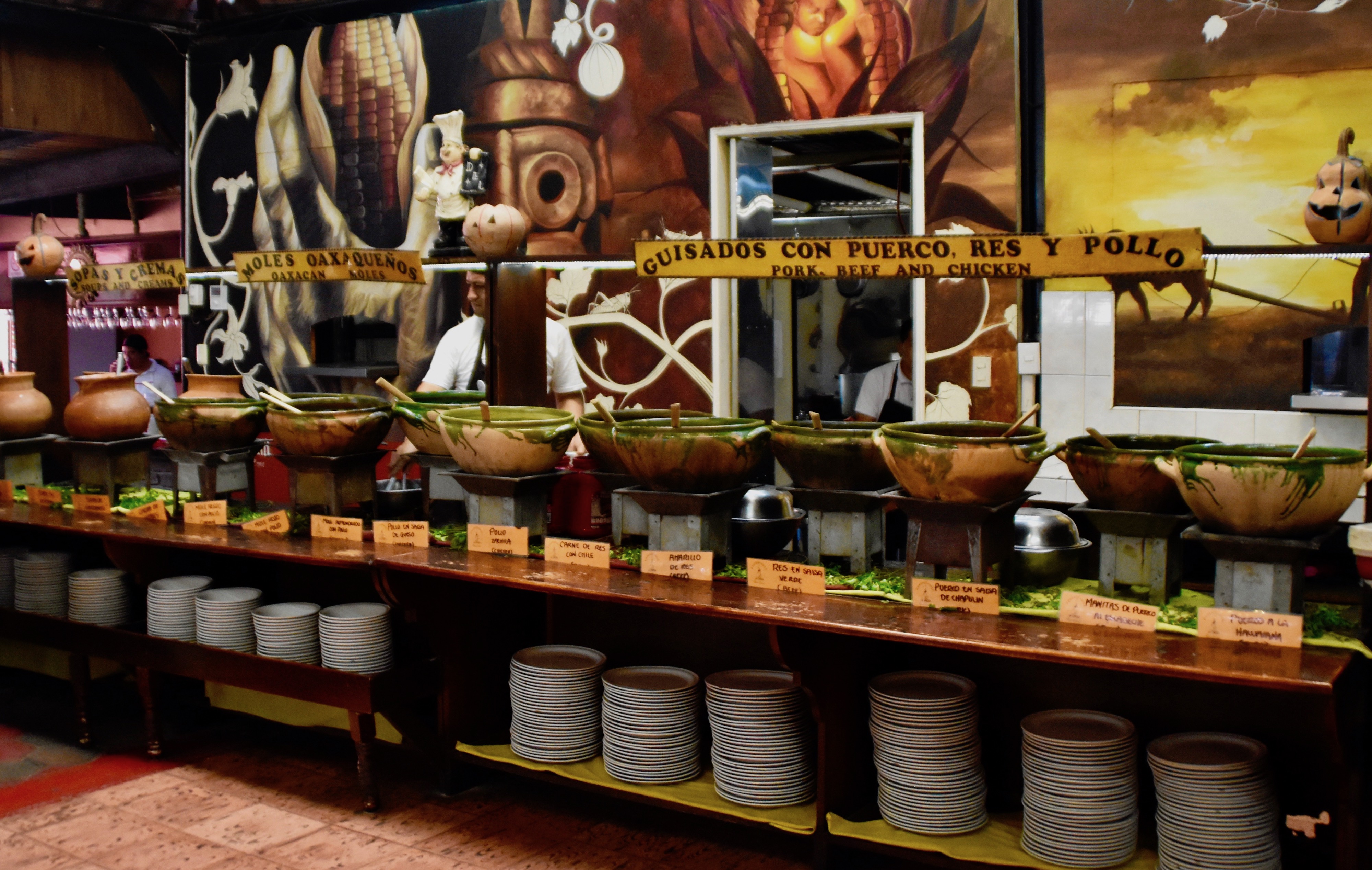
Time for Mezcal in Mitla
Victor had promised us that we would drop into a small mezcal distillery before heading back to Oaxaca and as usual he was true to his word. To set the record straight, mezcal is not a type of tequila, in fact it’s the other way around. Tequila is only made from the blue agave plant and the distilling process involves steaming the agave first. Mezcal can be made from any of a number of agave plants, also called maguey just to make things a bit more confusing. The mezcal process involves placing the agave hearts in a pit of hot stones and smoking them before the distillation begins. This gives mezcal the smoky, caramelized taste it is prized for.
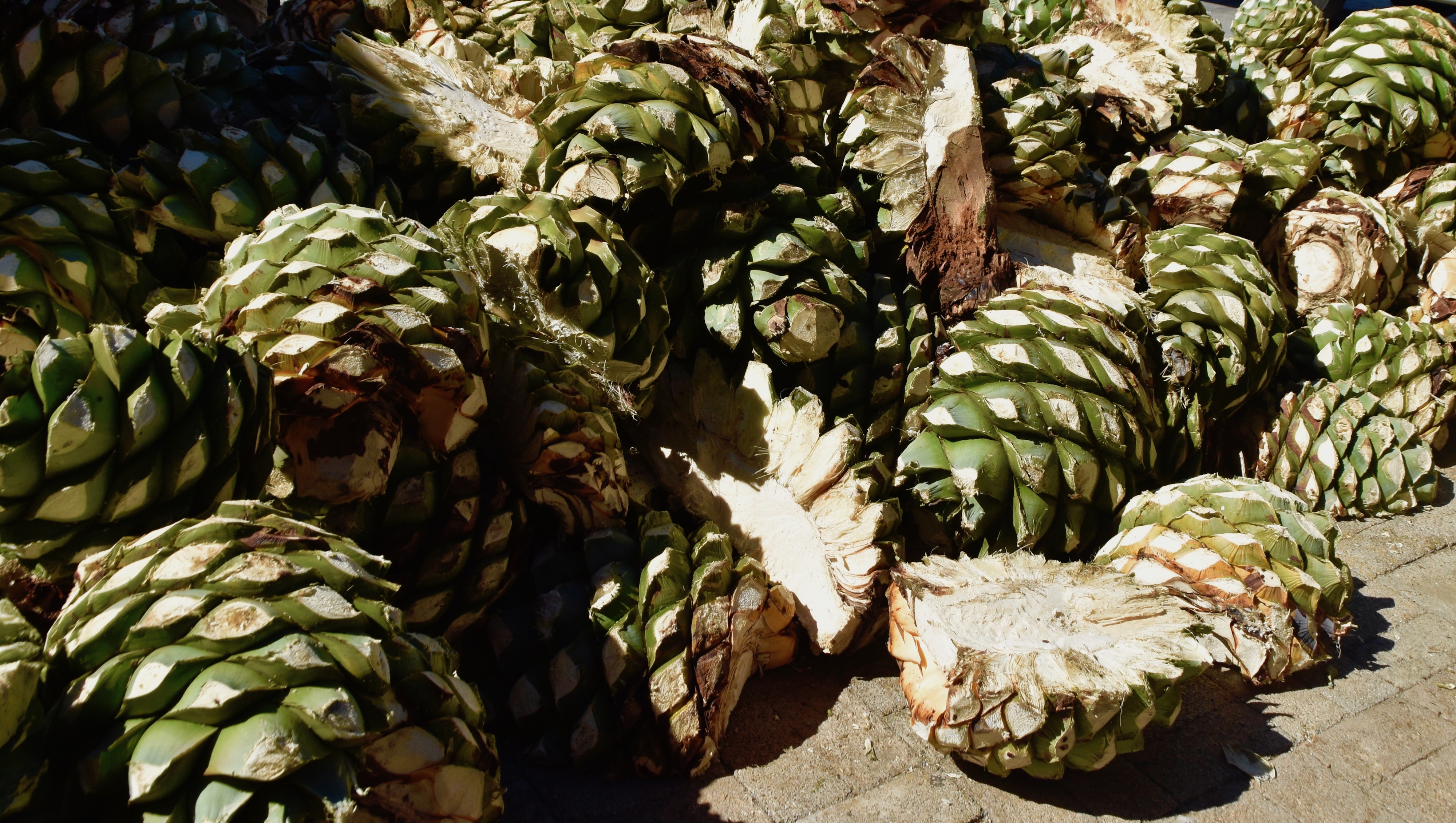
The mezcal distillery is in a small mostly open air space where there is this pitiful looking horse in a circular pit pulling a grindstone. I didn’t take a picture because I was not sure if this was meant to be a demonstration of how they used to make mezcal or it was how they were still making it. Either way it didn’t seem fair to the donkey, although I don’t believe he actually moved the grindstone during the entire time we were there.
We were provided with samples of three different aged mezcals from fairly young to well-aged. Obviously the deal was that the older stuff was supposed to be better. It was, but not appreciably so. We were also given the b.s. about the worms. Properly I’m told, mezcal should be chased with an orange slice that has been salted with a mixture of ground dried worms that live in the agave plants. How that evolved into chasing the mezcal with an actual worm on an orange slice, I don’t know. But after a few shots of mezcal I fell for it and ate the worm as well.
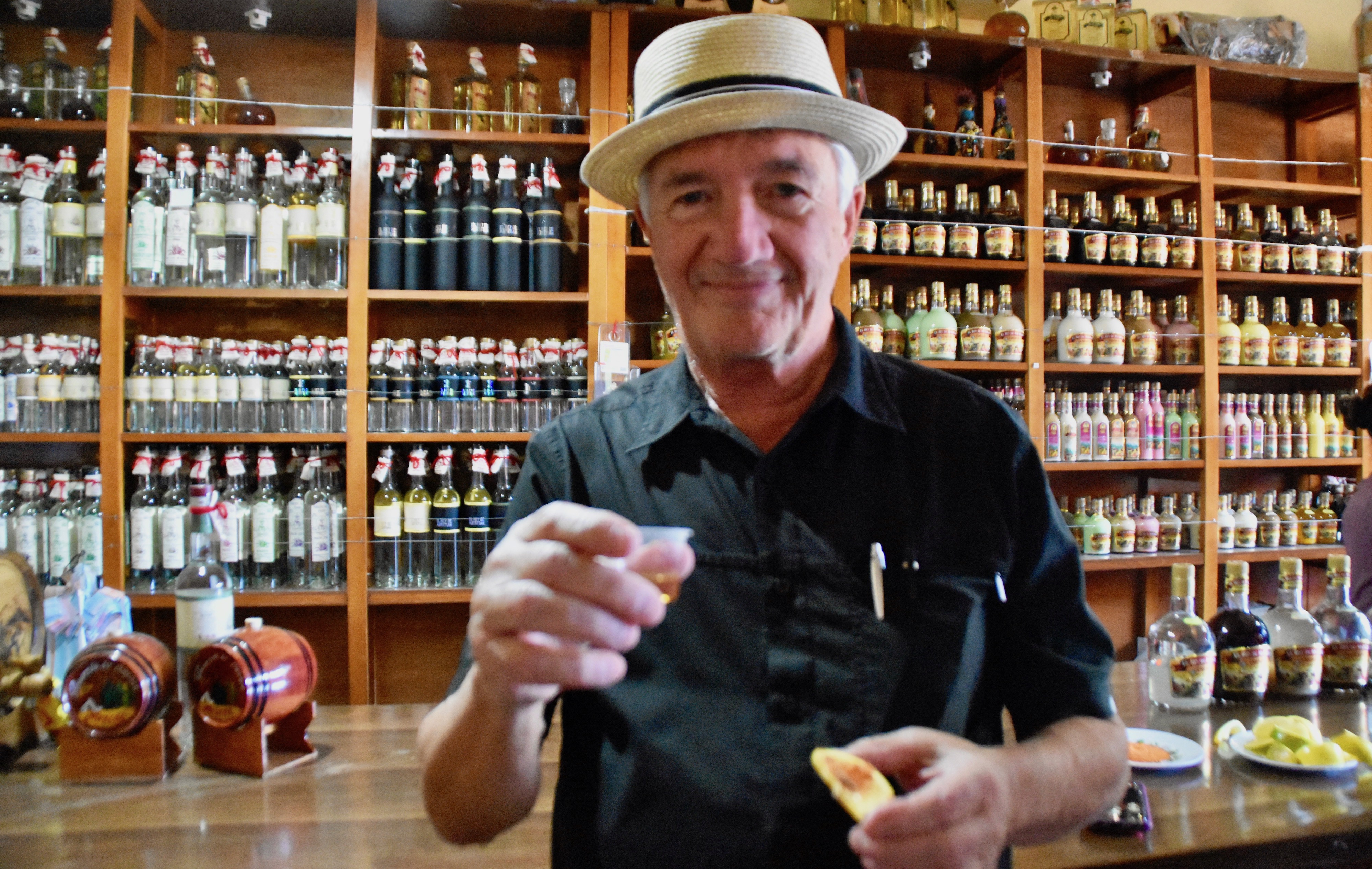
I’m not sure if the picture is fuzzy because Alison, who took it, had had one too many shots or if I had too many and was weaving. Most people would bet on the latter.
Anyway, it was a fun way to end a day of exploring the Oaxacan countryside.
Next we are off to the colonial city of Puebla which I understand is beautiful. Hope you’ll come along.

